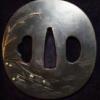Hi!
Thanks for info!
Sorry! Uwe, thanks for the correction! the situation is luckily not that bad :D . The correct measurement is 0.6 cm.
Yes, there is a difference in nakago and blade thicknesses, but nothing too drastic. Maybe I could calculate an estimate of the mihaba reduction by assuming that the togishi have preserved the original cross-section geometry and using the abovementioned difference as a scaling factor...
John, what is the approx ha width of your ko-mihara blade? Can you estimate the average distance from the hamon to the cutting edge? You probably meant sakikasane-0.7 cm??? Or else I win (after correcting my unit mistake) the second place only in competition for the most slender blade . If you have a measurement for the sakihaba, it would help me a lot!
Steve, do not worry! I still have the two fingers needed for typing replies
Martin, what a beautiful jihada you have there! Yes, near the hamachi my waki's ha is very narrow, but as you can see in the photos, it has a couple of millimeters more ha width closer to kissaki. In any case, we could estimate it has lost something like 5 mm.
Thanks to all of you for good answers!


